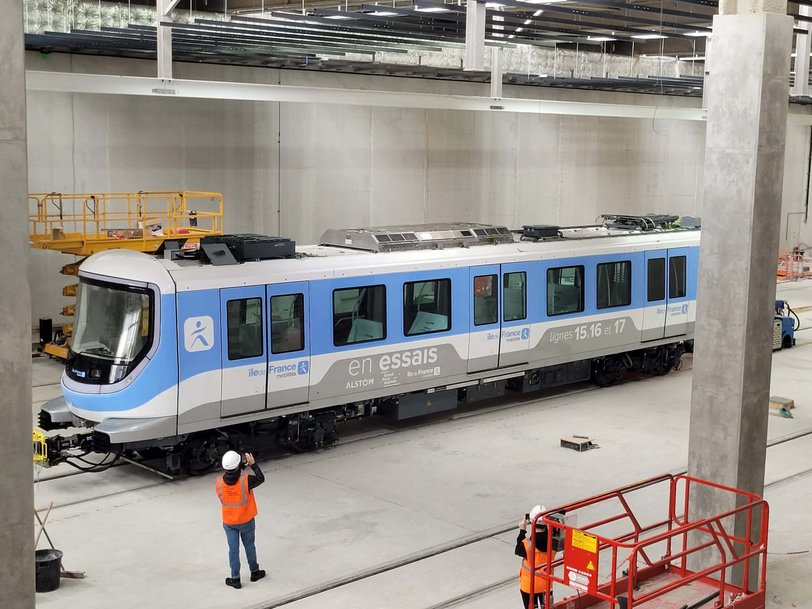railway-international.com
27
'23
Written on Modified on
Following the design phase, SYSTRA is supervising the production and testing of automatic metro trains for the Grand Paris Express
The very first metro train to run on line 15 of the Grand Paris Express was delivered on 22 June to the Champigny maintenance and storage site.

This is a major milestone in the progress of the Grand Paris Express: the delivery of the first of the 27 trainsets planned to carry passengers on line 15 South, when it enters service at the end of 2025. These trains are an adapted version of the ‘Metropolis’ range built by Alstom on the basis of preliminary design studies carried out by SYSTRA teams.
Our work was carried out as part of the dual assignment for Systems Integration Assistance (ISG) on lines 15, 16 and 17, and Rolling Stock and Automatic Control System project management (MOE MR/AC) for the Société du Grand Paris.
The arrival of the first train is an important milestone for the Grand Paris Express project, which is entering a new phase. It’s a milestone that provides a concrete illustration of the approach to testing and entry into service! We are proud to be contributing, alongside Société du Grand Paris, to this extraordinary project, at the service of users in the Greater Paris region.
Didier Traube, CEO SYSTRA France
Two years of dynamic testing before entry into service
Before delivery to the Champigny maintenance and storage site, the first trains will have undergone 10,000km of endurance tests*, first on the 1.8km test ring at Valenciennes, then in the tunnel on line 15 South. These tests, also known as ‘burn-in’, began several months ago.
"After the static and then dynamic tests at Valenciennes, the first train reached the maintenance and storage site at Champigny. Throughout this unique railway design project, SYSTRA France’s skills were mobilised, and I would like to congratulate the teams involved."
Guillaume Perche, Project Manager for Rolling Stock Interfaces
What does this mean in concrete terms? Each trainset is fitted with sensors, and our SYSTRA engineers check that all the systems are working, and that the behaviour, traction and braking performance of each trainset are in line, even in demanding situations. This ensures, among other things, that each train stops correctly within the specified distances. Vigorous braking and speed increases are carried out to test all the equipment. The connection between the train and the platform doors is tested at all stations, and trains are driven to and from the maintenance and storage site. These tests were carried out in manual mode with a driver, then in automatic mode without a driver.
All the tests will be spread over two years, so that every train can be checked before the entry into service of line 15 South, from Noisy-Champs to Pont-de-Sèvres.
Key facts – Trains for the Grand Paris Express
183 trains ordered
133 MR6V trains for line 15 (length: 108m)
50 MR3V trains for lines 16 and 17 (length 54m)
500 to 1,000 passengers per train, 20% of seats
Full PRM accessibility
Fully automatic driving
Width: 2.80m (greater than the 2.40m gauge of the Paris metro)
Iron bearing
Powered by a 1,500-volt DC catenary
3 access doors per side
Full interlocking (Boa train)
Maximum speed: 110km/h
Deliveries: 2023 to 2030
Production: France (Valenciennes)
Did you know?
The MR3V/MR6V trainsets belong to Alstom’s ’Metropolis’ range, the name given to all the metro trainsets produced by this manufacturer. Although specific to the Grand Paris Express, they share a common base and management systems similar to those used in metros in Sydney, Barcelona, Budapest, Dubai and Singapore! Other countries will soon be using these trains, including Canada for the REM and Chile for the Santiago metro line 7. In the Greater Paris region, the trains will be connected (USB sockets, WiFi), air-conditioned and equipped with video protection cameras.
*The first two trains will undergo 10,000km of endurance tests before acceptance, then the tests will increase to 1,000km for trains 3 to 10, and 150km only in tunnels on the Grand Paris Express for subsequent trains.
www.systra.com

